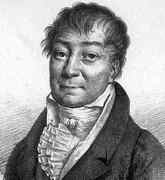Person: Burckhardt, Johann Karl

Johann Karl Burckhardt was a German-born astronomer and mathematician who is remembered for his work in fundamental astronomy and for his lunar theory.
Mathematical Profile (Excerpt):
- In addition to being enthusiastic about his studies of mathematics, Burckhardt purchased a German translation of Lalande's astronomy text which inspired him to begin to make astronomical observations.
- At the Gymnasium in Leipzig Burckhardt had good language tuition and gained expertise in French, English, Spanish, Dutch and Swedish.
- At Easter 1792, Burckhardt entered the University of Leipzig but his initial intention was not to study mathematics but rather to obtain a law degree.
- In 1795 he was awarded a scholarship which had been donated by Karl Friedrich Kregel von Sternbach (1717-1789) to support the study of mathematics and astronomy.
- Hindenburg advised Burckhardt to use the scholarship to study at Gotha under Franz Xaver von Zach.
- One of the main aims of the observatory was to make a systematic search for comets and Burckhardt took part in this project.
- The coadjutor of Mainz and of Worms, Karl Theodor Anton Maria von Dalberg, who later Archbishop-Elector of Mainz and Arch-Chancellor of the Empire, visited the Seeberg observatory several times and took a special interest in Burckhardt.
- On Zach's recommendation Hans Moritz von Brühl, a German diplomat and astronomer who lived for much of his life in London, England, offered Burckhardt a position as director of his observatory in Harefield, near London.
- But Burckhardt went to France rather than to England, for Zach had also recommended him to his friend Joseph-Jérôme Lalande in Paris.
- On various occasions Lalande praised Burckhardt for being a tireless observer, rapid calculator, and a translator making French science known in Germany.
- In the same period, Burckhardt established a quick method for calculating the orbit of a comet given limited data, a method applied successfully to the orbit of the first asteroid discovered, by Giuseppe Piazzi, on 1 January 1801.
- In 1799 he took French nationality and from that time used the name Jean Charles Burckhardt.
- Burckhardt published articles in Zach's Monatlicher Correspondenz, Bode's Jahrbüchern and in the Astronomischen Nachrichten.
- The Bureau des Longitudes had to chose the best lunar tables for their astronomical almanac, the "Connaissance des Temps" Ⓣ(Understanding time), so they appointed a committee consisting of Laplace, Delambre, Bouvard, Arago and Poisson to compare Burckhardt's tables with those of Johann Tobias Bürg, an astronomer working in Vienna, that were the most accurate available at the time.
- Burckhardt had used, probably for the first time, the method of least squares to find the best approximation from his data.
- The committee used a sum-of-squares method to compare Burckhardt's and Bürg's tables, coming to the conclusion that Burckhardt's were the most accurate.
- Burckhardt was a member of various academies including the American Academy of Arts and Sciences to which he was elected on 22 August 1822.
- We have one final aspect of Burckhardt to consider, namely his views on the teaching of mathematics.
- We know of these since Jean-Denis Barbié Du Bocage, a leading geographer and fellow member of the Institut National des Sciences et des Arts, wrote to Burckhardt asking for his advice on the mathematical education of his son.
Born 30 April 1773, Leipzig, Saxony, now Germany. Died 22 June 1825, Paris, France.
View full biography at MacTutor
Tags relevant for this person:
Astronomy, Origin Germany, Physics
Thank you to the contributors under CC BY-SA 4.0! 

- Github:
-

- non-Github:
- @J-J-O'Connor
- @E-F-Robertson
References
Adapted from other CC BY-SA 4.0 Sources:
- O’Connor, John J; Robertson, Edmund F: MacTutor History of Mathematics Archive
